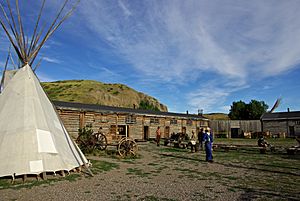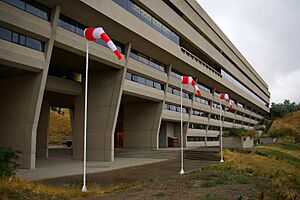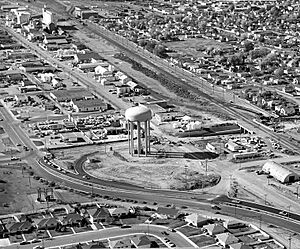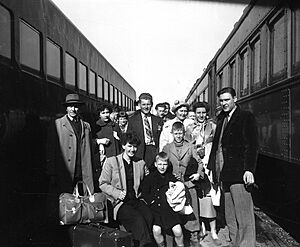History of Lethbridge facts for kids
The modern history of Lethbridge began in the mid-1800s. This area, now known as Lethbridge, Alberta, was once called Coal Banks. It was part of the land belonging to the Blackfoot Confederacy. This group included the Kainai Nation, the Northern Peigan, the Southern Peigan (Blackfeet), and the Siksika Nation.
The city started to grow when coal mines were opened. Nicholas Sheran began mining in 1874. Later, the North Western Coal and Navigation Company started its operations in 1882.
Contents
Early Days in the 19th Century

In 1869, the United States Army made it illegal to trade alcohol with the Blood nation in Montana. Because of this, traders John J. Healy and Alfred B. Hamilton set up a trading post. It was called Fort Hamilton and was located near the St. Mary and Oldman rivers.
This fort was later burned down, but they rebuilt it. People started calling it Fort Whoop-Up. The drinks traded here were often not very good.
The trading of these drinks caused some trouble. In 1873, some Americans caused a terrible event involving many Assiniboine people in the Cypress Hills area. Because of this, the North-West Mounted Police (now known as the RCMP) were formed. A group of these police officers came to southern Alberta to stop the illegal trade and bring order.
The NWMP arrived at Fort Whoop-Up on October 9, 1874. In 1875, they even set up a small police post inside Fort Whoop-Up. They rented a room from Healy and Hamilton. For the next twelve years, the fort continued to trade other goods, and the NWMP stayed there.
Coal Mining Begins
By the 1870s, Nicholas Sheran, an American businessman, found a coal seam. This was in the valleys on the west side of the Oldman River. He dug up coal and sold it to traders from Montana and to the NWMP.
Sir Alexander Tilloch Galt noticed how well Sheran was doing. He knew that a major railway would soon be built nearby. This railway would bring many new settlers. These settlers would need coal, creating a good market for it.
So, on October 13, 1882, Galt's company, the North Western Coal and Navigation Company, opened its first coal mine. It was right across from Sheran's mine. This new mine was managed by William Stafford. The town was named after the company's first president and biggest owner, William Lethbridge.
Lethbridge in the 20th Century
At the start of the 1900s, the coal mines employed about 150 men. They produced around 300 tonnes of coal every day. During World War I, coal production reached its highest point. Ten mines employed 2,000 miners and produced 1 million tonnes of coal each year. At that time, the mines in the Lethbridge area were the biggest coal producers in the Northwest Territories.
After the war, people started using more oil and natural gas. This caused coal production to go down. The last coal mine in Lethbridge closed in 1957. Part of this mine, Galt No. 8, is still standing today. A local group is trying to fix it up to become a museum or a place where people can learn about its history.
The Importance of Rail
The first rail line in Lethbridge was finished on August 28, 1885. It was built by the Alberta Railway and Coal Company. This line was later extended for 595 kilometers beyond Lethbridge. It was very important for connecting to the main CPR lines. In 1912, the ARCC sold this line to the CPR.
The railway industry relied on coal, and the CPR helped many immigrants settle in southern Alberta. Because of this, Lethbridge became a key railway center. This was very important for the region's economy. In the mid-1980s, the train yards in downtown Lethbridge were moved to nearby Kipp. After that, Lethbridge was no longer a main hub for train traffic.
The Riot of 1907
On December 25, 1907, an incident happened at the Dallas Hotel (now the Coalbanks Inn). It was on 5 Street South in downtown Lethbridge. Reports said it was between a Chinese employee of the hotel's restaurant and a customer.
News of this incident spread quickly. It somehow turned into false rumors that the employee had harmed the customer. As a result, a large crowd gathered at the hotel. They caused damage to the restaurant. Soon after, they moved to nearby Chinatown and caused more trouble there.
At this point, the local police gathered to control the situation. Mayor W. S. Galbraith read the Riot Act to the crowd. This helped bring everything under control, and the crowd soon left.
City Development and Growth

In 1905, the CPR moved its main railway point from Fort Macleod to Lethbridge. This made Lethbridge a major center for Southern Alberta. Before this, the region didn't really have one. Between 1907 and 1913, Lethbridge grew very fast. It became the main place for marketing, distribution, and services in southern Alberta.
Many city projects, a building boom, and rising land prices changed the mining town into an important city. One reason for these city projects was that Lethbridge was chosen to host the 7th International Dry-Farming Congress in 1912. Just a year before, in 1911, the city didn't have the facilities to host such a big event.
By October 1912, when the event happened, the city had spent $1.35 million. They paved downtown streets, put in cement sidewalks, improved water and sewer systems, and built a streetcar system. They also created Henderson Park and set aside 60 acres (24 ha) for the Exhibition Grounds.
Thousands of people came to the event from Canada and places like China, Italy, and India. However, the city's small tax base, with only 8,000 residents, could not easily pay for all these improvements. The city carried this debt for many decades. Even so, the Lethbridge Herald newspaper called the event "the greatest week in the history of the city."
Between World War I and World War II, the city's economy slowed down. Development was slow, dry weather forced farmers off their land, and coal mining quickly declined. After World War II, irrigation in the areas around the city helped it grow. More water meant more farming, which brought more people. This helped the local economy. Lethbridge College (then Lethbridge Community College) opened in April 1957. The University of Lethbridge opened in 1967.
How Lethbridge Got Its Name
Before people settled here, the area where Lethbridge is now was called The Arid Region. This meant it was a very dry place. Around 1880, surveys showed there was a lot of coal. So, it became known as The Belly River Coal District.
Around 1900, the Galts started using irrigation to bring water to the dry land. After this, the area was called the Irrigated District. Later, to help sell land, the parts that couldn't be irrigated were called The Winter Wheat Lands.
The area was also known by many other names:
- Blackfoot names:
- Aksaysim or Steep Banks
- Mek-kio-towaghs or Painted Rock
- Assini-etomochi or Where We Slaughtered the Crees
- Sik-ooh-kotok or Coal
- Sarcee name:
- Chadish-kashi or Black/Rocks
- Cree name:
- Kuskusukisay-guni or Black/Rocks
- Stony name:
- Ipubin-saba-akabin or Digging Coal
- English names:
- Coal Banks
- Sherans or Sheran's Ferry
- The Crossing
- The Colliery
- Newlethbridge
- Lethbridge Colliery
- Upper and Lower Town
- Coalhurst
- Riverside
Since October 15, 1885, the official name has been Lethbridge. People were already using the name Lethbridge unofficially for the community by the river as early as May 1884.
See also




